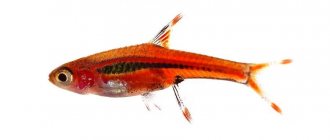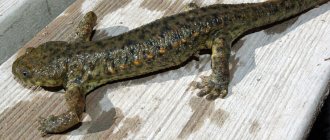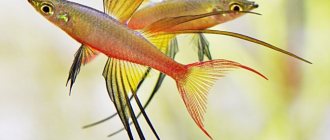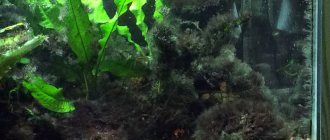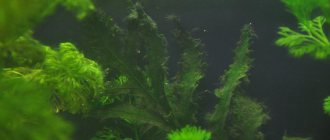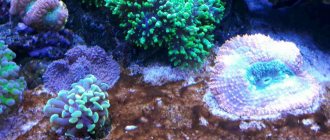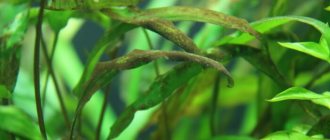03/15/2019Aquarium0
Vietnamese is a real aquarium weed that is rarely or improperly cleaned. Under certain conditions, it spreads quickly, seriously damaging higher aquatic plants. Therefore, aquarists and hobbyists should know how to prevent its occurrence and development.
- 1 Botanical description and natural habitat
- 2 Reasons and conditions for the appearance
- 3 Mr. Tail recommends: how to distinguish a Vietnamese from a Beard
- 4 How to deal with Vietnamese 4.1 Mechanical
- 4.2 Chemical
- 4.3 Biological
Description
Beginner aquarists first need to define the concepts. In the minds of many, algae are all the green (or some other color) plantings in the aquarium. In fact, these are lower aquatic plants that either cling to any surfaces or are simply “free floating”. Externally they may look like moss, mucus, thread-like tufts. There are thirty thousand species of them in nature.
The Vietnamese consists of bundles, the length of the hairs in which does not exceed two centimeters. It is located on the tips of the leaves, gradually covering the entire surface of the leaf, and also on the stems of plants, especially on their bends, on any decorative objects (stones, grottoes, artificial plants), on their irregularities and protrusions.
Why is Vietnamese considered a red algae, since its color is dirty gray, brown or black? It all depends on the presence of special coloring pigments. In Vietnamese it is red and is detected only experimentally, under the influence of alcohol or some solvent such as acetone.
Kinds
Vietnamese is a type of red algae. The name indicates its geographical homeland. And the “victorious march” through other countries of the world began, according to experts, during the export of some plant products from Southeast Asia.
Among the Vietnamese's close relatives are algae, which are grouped by color. If the Vietnamese algae is red, then there are also brown, blue-green, yellow-green and simply green algae, and even golden.
Kinds
Vietnamese is a type of red algae. The name indicates its geographical homeland. And the “victorious march” through other countries of the world began, according to experts, during the export of some plant products from Southeast Asia.
Among the Vietnamese's close relatives are algae, which are grouped by color. If the Vietnamese algae is red, then there are also brown, blue-green, yellow-green and simply green algae, and even golden.
FACT: The Latin name for Vietnamese is Audocinella. In addition, it is called purple, compsopogon and red beard.
Why is it harmful to an aquarium?
The Vietnamese woman forces all the inhabitants of the aquarium to live by their own laws , and the person to spend all his strength trying to get rid of her. Many people, after several unsuccessful attempts, simply give up from the inability to cope with the enemy.
One can only marvel at the resilience of the flip-flop: it penetrates into the plant body, tightly clings to the soil, and covers the walls of the aquarium and the parts of the equipment used in a dense layer . Moreover, this algae is not a parasite in the literal sense of the word, that is, it does not feed on plant juices. It settles on them as a kind of foundation and thereby destroys living tissue. In addition, it deprives plants of sunlight and accelerates their death.
The loss is especially acutely felt by the owners of collections of aquatic plants, who with love, with large material investments, equipped their home underwater world - and suddenly all this perishes literally before our eyes.
Difference from beard
Vietnamese is often compared to algae called “blackbeard”, and sometimes they are even confused. Although there are purely external differences that are quite easy to understand: the flip-flop grows in the form of a bush, and the beard resembles a fringe of long thin threads .
There are slight differences in lifestyle and preferences. The beard finds shelter in any part of the aquarium, and the Vietnamese woman chooses for herself (at least at the beginning of her victorious procession) corners located away from the current, for example, stones and grottoes.
As for survivability, the Vietnamese is beyond competition in this matter. It is very strong, tough and “sticks” to any surface so much that great physical effort is required to get rid of it. With a black beard it’s easier in this sense.
Another difference: no one will eat the Vietnamese except for snails (and not all of them, but only one or two species), and algae-eating fish can cope with the black beard.
Conditions for occurrence in the aquarium
The appearance of flip flops in an aquarium, according to experts, is almost inevitable if there is dirt and disorder in them: food remains on the bottom, fish excrement that has not been removed for a long time. But there are other reasons. Even neat aquarists can at one “wonderful” moment detect signs of red algae if:
- there is not enough oxygen in the water;
- aquarium equipment creates too powerful a current;
- blowing is stronger than required;
- there are a lot of inhabitants - both fish and plants.
The composition of the water also matters . If the water has a high content of nitrates and phosphates, this can be one of the impetuses for the colonization of the aquarium with algae.
There is evidence that illumination with lamps with a yellow spectrum (rather than fluorescent) also makes a negative contribution: such light does not benefit higher plants, but accelerates the development of lower ones - Vietnamese plants grow by leaps and bounds. The same effect is obtained from exposure to sunlight, so aquarists are advised to protect their underwater world from direct exposure - find a place in the apartment where the sun’s rays do not reach directly.
Not all plants are affected equally by Vietnamese. Its first victims are plants that develop more slowly than others and are broad-leaved (for example, Echinodorus and Anubias). They certainly cannot be saved if the red algae has begun its dirty work. But there will be a struggle for the fate of the rest.
Newly launched aquariums are most often at risk because, as experts note, they do not yet have a clearly established nitrogen cycle. In addition, in this situation, as a rule, beginners have to fight a Vietnamese woman and they lack basic experience and skills. In a confrontation with a Vietnamese woman, a quick understanding of the situation and a quick response are important.
It is believed that in a new aquarium the appearance of algae (of any kind) is a normal process. The only important thing is to take control of it. Filtration of water, and sometimes its partial replacement, helps with this. When the plants you planted begin to settle down and feel like masters, they will take away food from the algae and stop their growth. The situation will be resolved in your favor.
Ways to independently counteract
The fight against red algae begins with mechanical measures. First of all, remove them manually - as many as possible . It is necessary to remove from the water all the stones and objects intended for decoration, but now occupied by the Vietnamese. Don't rush to throw them away: after you clean them, boil them in water for twenty minutes, they can be used again.
Remove the plants from the water and rinse under the tap (the water should be running). All diseased fragments must be removed, even if they were damaged not by red algae, but for some other reason. The fact is that your enemy first of all attacks old and diseased, rotting plants - you cannot leave him a chance for another attack.
You also need to carefully work on the rest of the contents of the aquarium: the sand is cleaned and siphoned, thermometers are treated with alcohol, snags are boiled in boiling water, just like stones.
If the item cannot be boiled (it will not withstand high temperatures and will simply have to be thrown away), use a preparation that is sold in hardware stores under the name “Whiteness”. Dilute it in water, leave the item being treated in it for two to three days. Within a day, the flip flop clinging to him will begin to turn grey, and by the end of the procedure it will completely dissolve. If at the same time the color of the object that you were processing suffers, you will have to come to terms with it - you simply have no other option, since there is no way to ideally clean some spongy surface of a stone or intricate artificial plants.
In addition to mechanical methods of struggle, there are also scientific ones. Their purpose is to ensure biological balance in the aquarium . This means that you should always control the number of fish and plants , avoiding “overpopulation” of the aquarium. It may be necessary to abandon those species of fish (relocating them to another place) that dig too actively in the soil, polluting it with waste products and food residues. Regarding food, you also need to figure it out - its quantity should be sufficient, but not excessive.
Inspect your green spaces. Try to plant the fastest growing species (hornwort, hygrophila, vallisneria). They will begin to actively feed, taking nutrients from the water, not giving the algae a chance to “raise their heads.”
By the way, the level of phosphates today can be controlled using chemicals. These are the so-called absorbers. They are produced in the form of granules, filling them into a mesh bag and placing them in the filter housing.
Reasons for appearance
Harmful algae begins to appear in the aquarium when there are problems with the fish. Reproduction occurs with the help of spores, which enter the aquarium only with purchased algae. Infection can also occur through dirty equipment, fish from another body of water, or plants of unknown origin. Disputes live even in the most hostile environments. It feeds on organic substances carried by currents or the fish themselves. Organics can be found in or rising from the bottom. Organic matter forms a kind of cloud around the plant bush. Most fish do not eat Vietnamese fish.
To stop the growth of the plant, you can limit the light supply in the aquarium. Harmful tufts appear in aquariums with muddy bottoms, as well as where there are fish that feed on the bottom of reservoirs. At the same time, a lot of organic matter rises from the bottom, which helps saturate the plant with nutrients. It is better not to overpopulate the aquarium with fish, since their waste is deposited in the mud and acts as organic nutrients for the growth of the tufts. Reproduction and development of the plant is possible due to insufficient oxygen supply to the container. In this case, all damaged plants are quickly overgrown with pests.
Remedies against Vietnamese and their average price
On various forums, fellow sufferers share information about what medications they used to try to get rid of Vietnamese and what came of it. Unfortunately, almost no one has found a panacea .
Preparations with boric acid and borax gave a temporary encouraging effect: the Vietnamese fish slowed down its growth and seemed about to disappear. However, in the end, it was not she who suffered, but good plants (for example, cryptocorynes lost all their foliage), and strange things appeared in the fish’s behavior - they lost their appetite, began to scratch their bodies on the stems of plants and the ground. But they couldn’t get rid of the flip flops.
Copper plates and silver coins , which were supposed to make the water composition unacceptable for harmful algae, did not give the expected result after a month of use.
The drug “Algimin” (it is sold in pet stores) also proved too tough for the Vietnamese woman. On the third day after its use, the black bushes begin to crumble, after a week they disappear, and after three the algae takes revenge and, as if in retaliation for the disturbance caused, begins to grow more aggressively. Is there really no way out?
According to experts and practicing aquarists, the only drug that can fight and win is Sidex . It is considered the most effective against red algae and safe against higher plants. It does not accumulate in water during use, but oxidizes, breaking down into water and carbon dioxide. The effect of the drug on fish has also been tested: due to its bactericidal properties, it is a good prophylactic agent for representatives of aquatic fauna.
A liter of Sidex costs about six hundred rubles . 15 - 25 milliliters are required per hundred liters of aquarium water.
FAQ
Will algae ever die from chemicals?
No. The remedies act gradually, over 2–3 weeks. It is possible that the course will need to be repeated.
Can chemicals be dangerous for fish and snails?
This is not excluded. There is evidence that Algol can be toxic to snails, as well as young shoots of non-hard plants, especially in high dosages.
Can carbon dioxide really prevent algae growth?
Yes it is. Carbon monoxide, on the one hand, has a beneficial effect on the development of higher plants, on the other hand, it acidifies the water, which is bad for the weed.
What kind of water should be in the aquarium to prevent black beard from appearing?
It is desirable that the water be slightly acidified with low carbonate hardness. To do this, it is necessary to constantly test environmental parameters.
Remember that it is easier to avoid a problem than to solve it. If the algae has already appeared, then one control method most likely will not work. The best results are achieved by an integrated approach - for example, mechanical manual cleaning and the use of chemicals.
Prevention
Each new plant must undergo quarantine to avoid contamination of the aquarium with algae. We must remember that Vietnamese is infected “from the outside” and never neglect the little things, hoping for “maybe”.
It is necessary to monitor the composition of the water. For example, algae will not like a hardness higher than eight percent. Achieve these parameters using solutions of calcium chloride and magnesium sulfate (preparations are usually purchased at pet stores).
If you have already had to deal with red algae at least once, keep in mind: everything you have done to save your aquarium will not be in vain if you regularly change the water, which will not allow nitrates and phosphates to cross the acceptable level and create algae favorable conditions. Well, cleaning up fish excrement should be done regularly, the soil should be cleaned at least once a month.
Preventive measures
To avoid the need for treatment of aquarium inhabitants, it is worth preventing the occurrence and spread of Purple in the initial stages.
The following preventive measures are suitable for this:
- regularly remove excess food and fish excrement, clean the soil monthly and change the water weekly;
- maintain the optimal number of inhabitants and provide at least 10 liters of water per fish 5-7 cm in length;
- dilute vegetation with fast-growing species and use potash-free phosphate fertilizers for them;
- treat new plants with Bicillin-5, hydrogen peroxide, bleach or Penicillin;
- when acidity, hardness and carbon content decrease, increase them in a timely manner;
- avoid strong aeration, which creates current and muddies the water;
- use shading from direct sunlight, choose fluorescent lamps for illumination, changing them 1-2 times a year.
By observing such measures, it is not difficult to maintain an optimal habitat for fish. This will ensure the health of the aquarium inhabitants and will maintain the beauty of the underwater landscape.
Tips and facts
- Antibiotics have only a short-term effect on red algae, and most often do not cause any harm to them at all.
- One of the important conditions in confronting the Vietnamese is limiting the number of underwater inhabitants. How to determine the optimal number? According to experts, for ten liters of aquarium water there should be only one fish measuring five to seven centimeters.
- Not only ordinary, but even fluorescent lamps can play into the hands of red algae. But only if they have already served their term. It is advisable to change them once or twice during the year.
Photo and video

